|
History of Kluson® Tuners As Used By Gibson on 1950s and 1960s Gibson Les Pauls, SGs and ES-model Guitars
(All page setup, and text Copyright © by Rick Norman, January, 2023 - All photos by Rick Norman)
This page may not be linked to and posted on other sites without written permission from Rick Norman
Images on this page may not be used outside of this page without written permission from Rick Norman
Click here to visit my Grover Tuner Reference Page
Click here to visit my Gibson Electricals Reference Page
Kluson® tuners - love 'em or hate 'em, take 'em or leave 'em... these were the standard equipment on the huge majority of the Les Paul, ES, and SG type guitars we love so much throughout the 1950s and 1960s.
Over the years, it became a common practice to replace the original tuners (most commonly, with Grover Rotomatics), either because the originals were thought to be inferior, or because the originals wore out or got bent or broken. With current-day values of old Gibsons - the Les Paul line in particular - being so elevated, the value of these guitars is higher when they're in the most original condition they can be. As a result, many of these 'Grovered' guitars are being restored to their original Kluson®-equipped condition. Some people are lucky enough to own guitars where the original tuners were saved, and therefore the original tuners may be reinstalled. That's not the most common thing though, so many others are left to search out Kluson® tuners through vintage parts dealers who have acquired them from technicians and other sources. Naturally, it's important to people to have the same model tuners that were original equipment for the era their guitar was built. There are a lot of questions about which models were used when.
For people who are relatively new to the vintage market, there are a whole array of terms that are used to describe these different models that are confusing and misunderstood. Terms like: 'single-line', 'double-line', 'single-ring', 'double-ring', 'Pat. Appld.', 'D-number' and others are thrown around and they're used in combinations which tell which version is which. I'll attempt to cover as much of that as I can in this page. I'll refer to Les Pauls a lot in the various sections, but it can just as easily apply to other Gibson models of that era.
I've done vintage tuner restoration work for vintage parts dealers and private individuals for several years, and as part of that work, several years ago I had an occasion where I had nearly 40 complete sets of '50s and '60s Kluson® tuners spread out on my dining room table. Almost every one of the variations was present. Some interesting things were revealed by having them all together like that. I couldn't pass up the opportunity to document the variations in these tuners, since I knew it was unlikely I'd ever have this many beautiful examples in my hands at one time ever again.
This page only documents the individual tuners, not the strip tuners used on Les Paul Specials and Juniors and many other Gibson models. This also doesn't address the 'Super Tuners' used on high-end guitars in the '50s such as the Les Paul Custom.

Term Definitions
First, I'll define the terms. I was originally confused by a couple of them, and I'm sure others are too. I have the good fortune of being associated with a number of well-respected vintage parts experts who were generous enough to tolerate my questions and set me straight (as much as can be, anyway) on the variations.
- 'No-line', 'Single-line' and 'Double-line'. These terms actually refer to the presence or absence of the lettering found in the gear covers on the front of the tuners.
- 'No-line' refers to a generation of the tuners that had no writing or lettering in the central space on the gear cover.
- 'Single-line' refers to the generations that had the words "Kluson® Deluxe" stamped into the central space on the gear cover.
- 'Double-line' refers to the generation of the tuners that had two spaces on the gear cover, with either the word "Kluson®" or "Gibson" stamped into the left side and the word "Deluxe" stamped into the right side.
- 'Single-ring' and 'Double-ring'. These terms refer to the tuner buttons installed on the tuners.
- 'Single-ring' refers to buttons that have one raised ring at the narrow end of the button nearest the gear cover.
- 'Double-ring' refers to buttons that have two raised rings at the narrow end of the button nearest the gear cover.
- 'Pat Appld'. This term refers to the generations of tuners made prior to the award of Kluson's® patent.
- 'Patent No.' or 'D-number'. These terms refer to the generations of tuners made after Kluson's® patent was awarded.
- 'Small-hole' and 'Large-hole'. These terms refer to the size of the lubrication hole in the gear cover. There is a very common belief that the size of the lube hole is a direct indication of when a tuner was made.
Not so!
The truth is that the size of the hole varied over the different models, with the large-hole and small-hole versions sometime appearing and disappearing at different times. Sometimes both large and small-hole versions of a various generation tuner were installed on a given guitars at the same time.
Here's an example of a '59 with both small hole and large hole tuners from the factory.
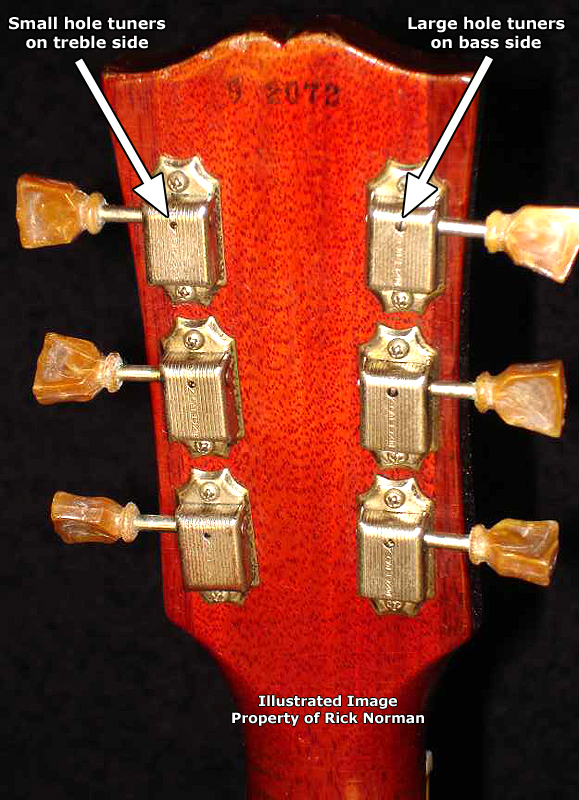

The Versions
Please note that there doesn't seem to be a definitive source proving exactly what years each tuner variation was introduced. While it could be deduced by looking at enough '50s Les Pauls (and later on, ES models and SGs), there was almost certainly some overlap when old stock of one model was still being installed on Gibson guitars even though the new model was in production. For example, while many of the early 1952 and 1953 Les Pauls came with Versions 1 and Version 2 tuners (shown below), there have been many Les Pauls of those years with the Version 3 tuners on them verified as original installations. Another example is that even though the double-ring, double-line version of the tuners was introduced in 1964, it appears that a huge majority (if not all) 1964 SGs and ES guitars were equipped with the earlier double-ring, single-line tuners, presumably as Gibson used up their existing stock. So there are no exact, absolute divisions on this subject. I've consulted with some knowledgeable people and this is as accurate as we can compile. I make no claim that this information is absolute, or complete. It is the best that I have been able to compile to date. So take what you will from this, and use it as an informational guide only.

Version 1
Early-'52 Les Paul Tuners
This version is seen in the very earliest 1952 Les Pauls, and often came with a hex-shaped bushing on the face of the guitar's headstock, instead of the round ones that universally followed.The most notable feature that separates these tuners is that the worm shaft does not go through the side of the gear cover. These are found with either the large or small lubrication hole. They can be classified:
Single-line, Single-ring, Often referred to as 'Sealed' tuners.
Here are some pictures of a really pristine example:
Here's a good shot showing a large lube hole; clear evidence that the large hole was in use in the early 1950s, and didn't appear in 1958/59, as many believe. Also notice the single raised ring at the base of the tuner button. (Note: this is a replacement tuner button provided by Uncle Lou, not an original button. This is a correct configuration for this model tuner.)
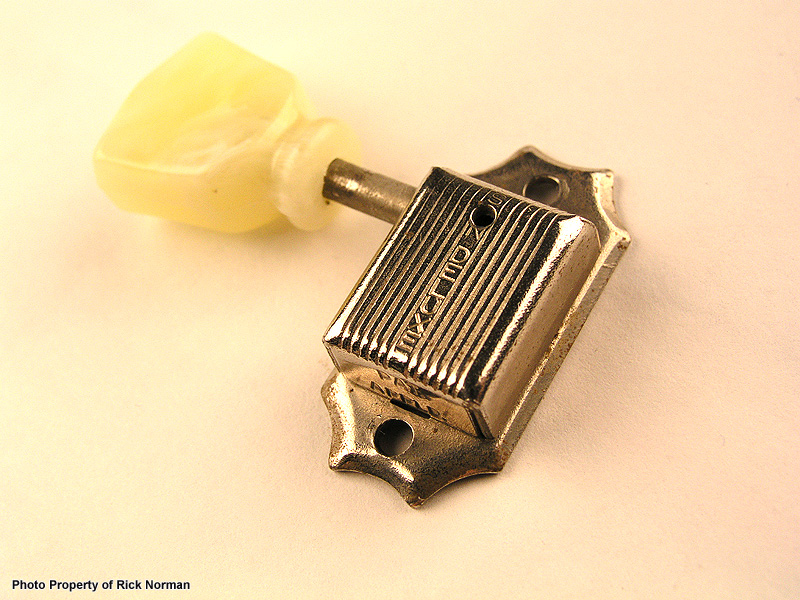
Another defining item unique to this model is the presence of the 'PAT. APPLD.' lettering on the bottom face of the gear cover.
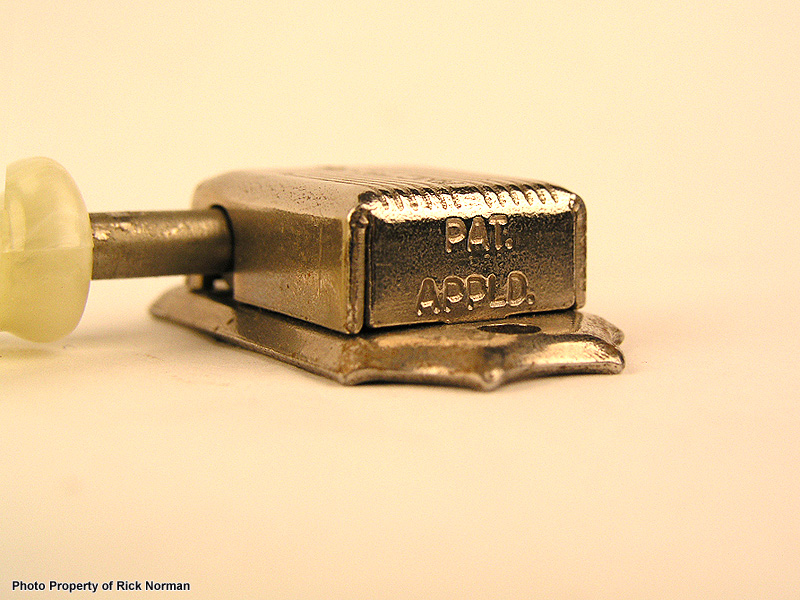
Here's another view of the side of the gear cover clearly showing that the worm shaft doesn't go through.
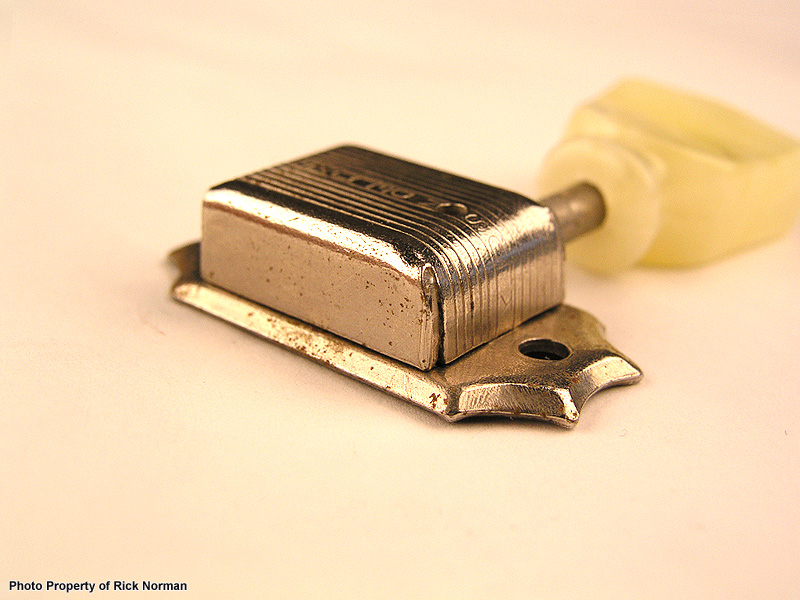
This is the under-side of the base plate. This shows the lettering that is common to all Kluson® tuners made prior to the award of Kluson's® patent. This lettering gives us the 'Pat Appld' term. This lettering is used all the way up through 1958.
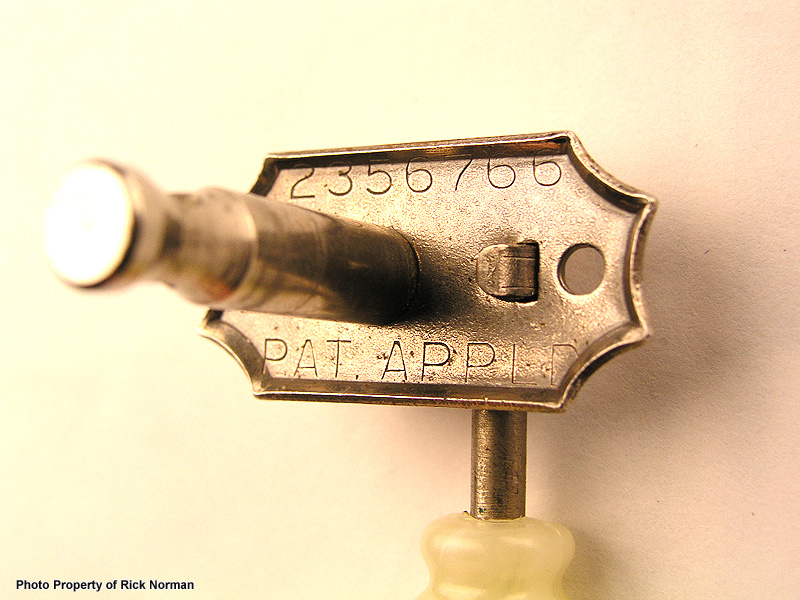

Version 2
1952 - 1953 Les Paul Tuners
This version is seen in the middle-to-late 1952 Les Pauls on into middle/late 1953 Les Pauls.These are a transition model that retains the gear casing without the worm shaft coming through, but the lettering in the middle of the gear cover disappears. These are also available with either the large or small lubrication hole. They can be classified:
No-line, Single-ring, Often referred to as 'Sealed' tuners.
Here are pictures of another pristine example, and please note that the back of these tuners look just like the example shown in Version 1, so please refer to that picture for the back view.
This is a very good shot of a small lube hole. Notice the lack of lettering in the center - hence 'No Line', and the worm shaft clearly not protruding through the side of the gear cover. (Note: this is a replacement tuner button provided by Uncle Lou, not an original button. This is a correct configuration for this model tuner.)
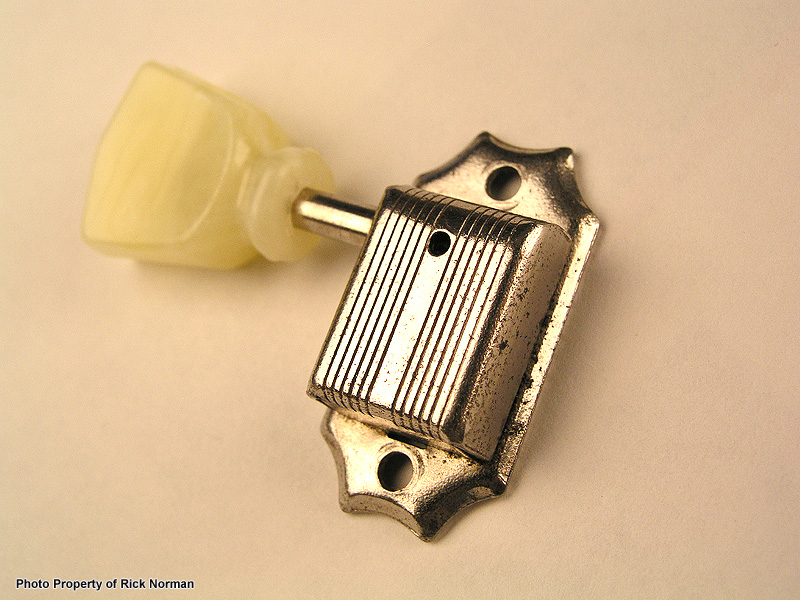
This model loses the 'PAT. APPLD.' lettering on the bottom face of the gear cover. Also notice that the vertical lines wrap around the bottom of the gear cover slightly; an indication that the stamping dies were still a work-in-progress.
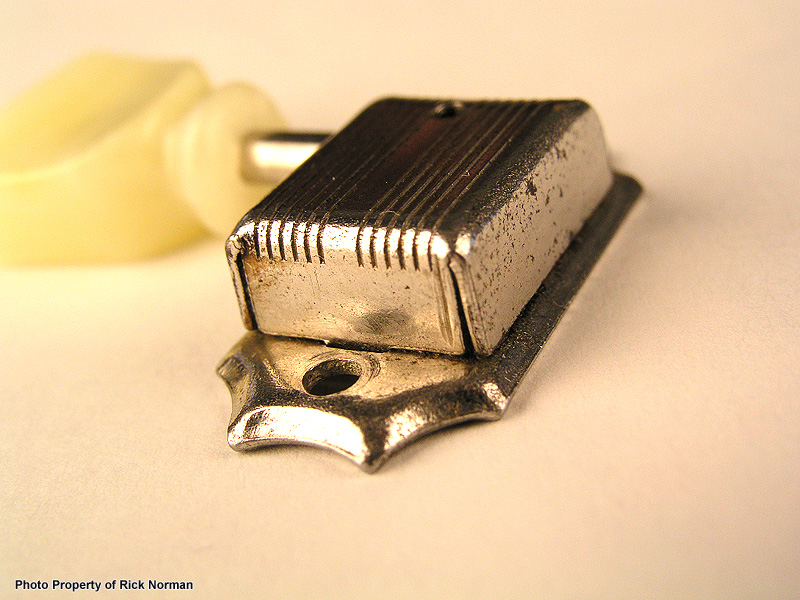

Version 3
1953 - mid 1956 Les Paul Tuners
This version is the first to have the worm shaft protruding through the side of the gear cover. They retain the feature of having no lettering in the center of the gear cover, however. They can be found with either the large or small lubrication hole. Here's how they can be classified:
No-line, Single-ring.
Here are some pictures of a clean example and please note that the back of these tuners look just like the example shown in Version 1, so please refer to that picture for the back view.
Here's another good example of a small lube hole. (Note: this example has its original tuner button.)
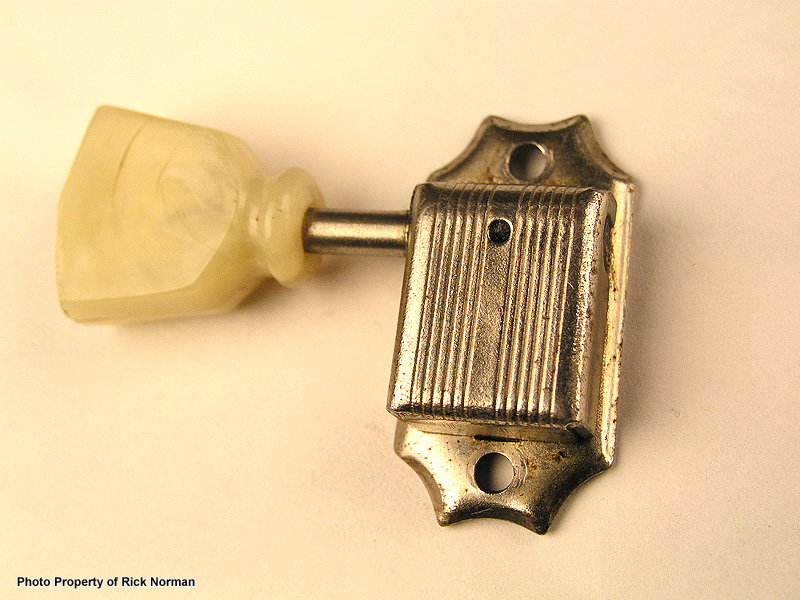
This model retains the plain facing on the bottom of the gear cover, which continues through to the end of the line.
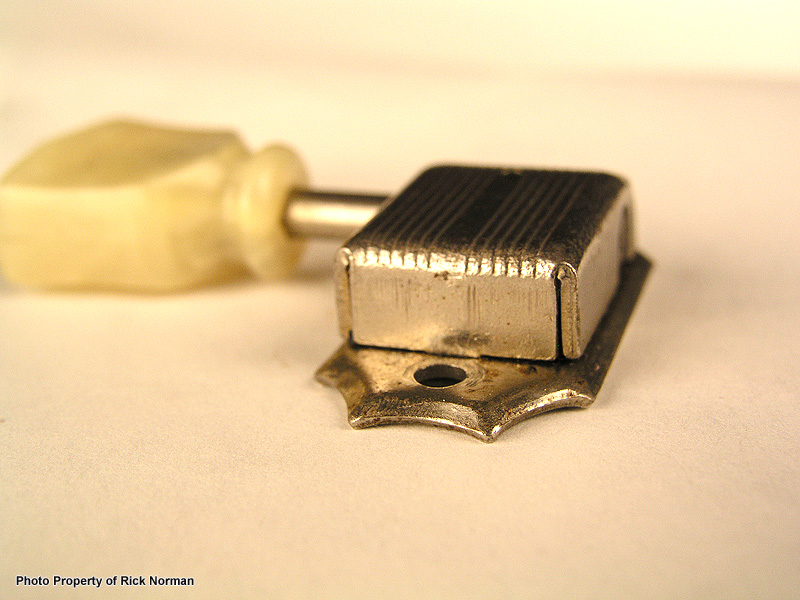
Here's a view of the side of the gear cover showing that the worm shaft now goes through the side.
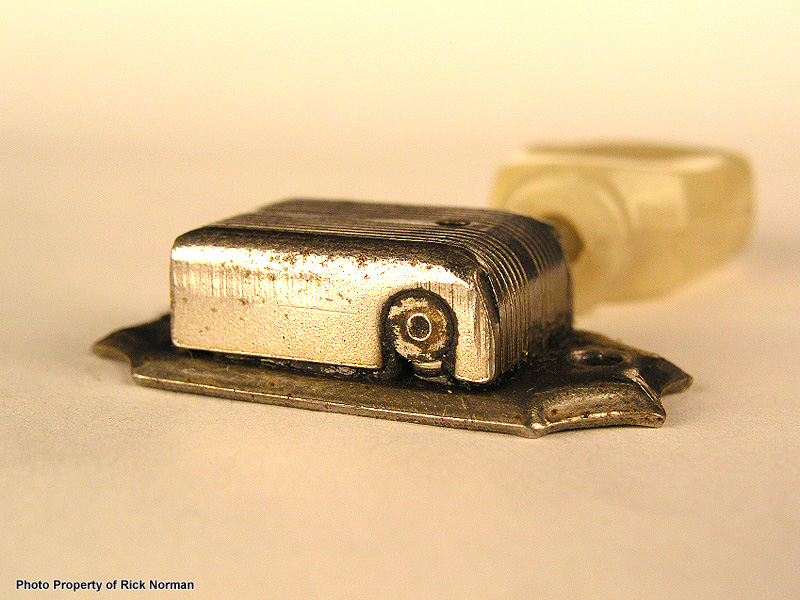

Version 4
Mid-1956 - Late-1958 Les Paul Tuners
This version brings back the lettering in the gear cover, and are still of the 'Pat Appld' era. They can be found with either the large or small lubrication hole. They can be classified:
Single-line, Single-ring, Popularly called 'Pat. Appld' tuners
Here's another good example of a large lube hole and please note that the back of these tuners look just like the example shown in Version 1, so please refer to that picture for the back view. Again notice the worm shaft coming through the side of the gear cover, which is now a continuous feature going forward. (Note: this is a replacement tuner button provided by Uncle Lou, not an original button. This is a correct configuration for this model tuner.)
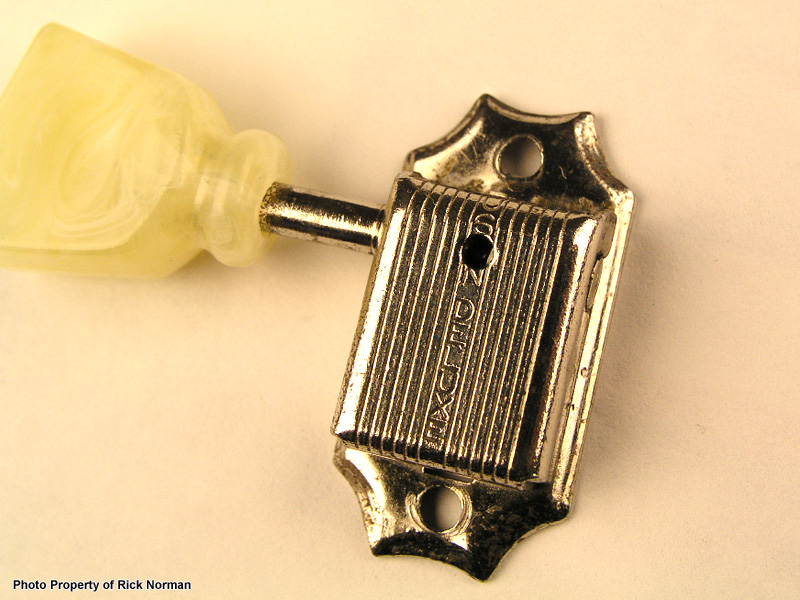

Version 5
Late-1958 - mid-1960 Les Paul Tuners
This version marks the beginning of the 'Patent No.' or 'D-Number' era. They first appeared in late-1958 and were used through the early-to-middle of 1960. 1958 was a transition year for these tuners, and there are documented cases of 1958 Les Pauls with a mix of both 'Pat. Appld' and 'Patent No' tuners original from the Gibson factory. Since they appear identical when viewed from the installed position, there was no reason not to use up the left-over 'Pat. Appld' tuners. Like the 'Pat. Appld' tuners, the 'Patent No' tuners can be found with either the large or small lubrication hole, although the vast majority of them are the large-hole version. These can be classified as:
Single-line, Single-ring, Popularly called 'Patent No.' or 'D-Number' tuners
Here's a picture of clean one. Notice the small lubrication hole, which is less-common in the single-line Patent No. tuners. (Note: this is a replacement tuner button provided by Uncle Lou, not an original button. This is a correct configuration for this model tuner.)
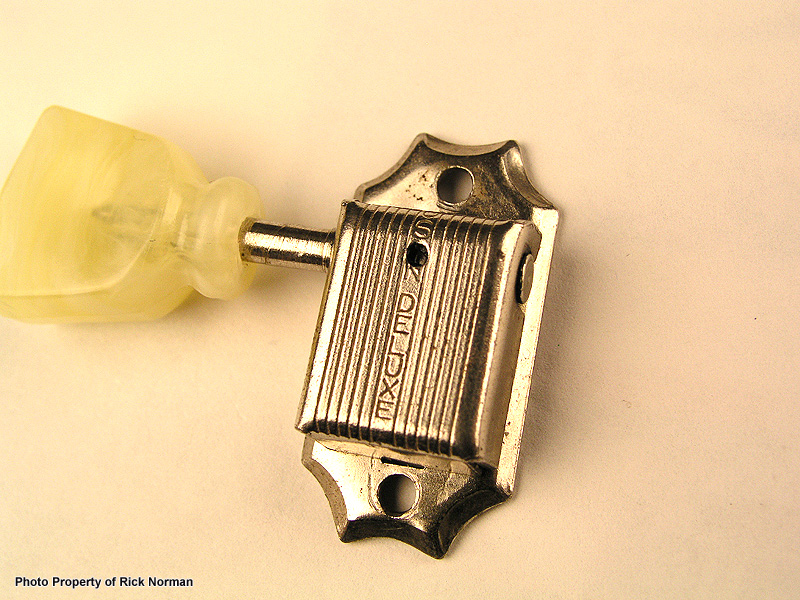
The important thing that changed is the under-side of the base plate. It now has different lettering and numbering. You can see why they're called 'Patent No' tuners, or 'D-Number' tuners. All future tuners have this stamped into the base plate.
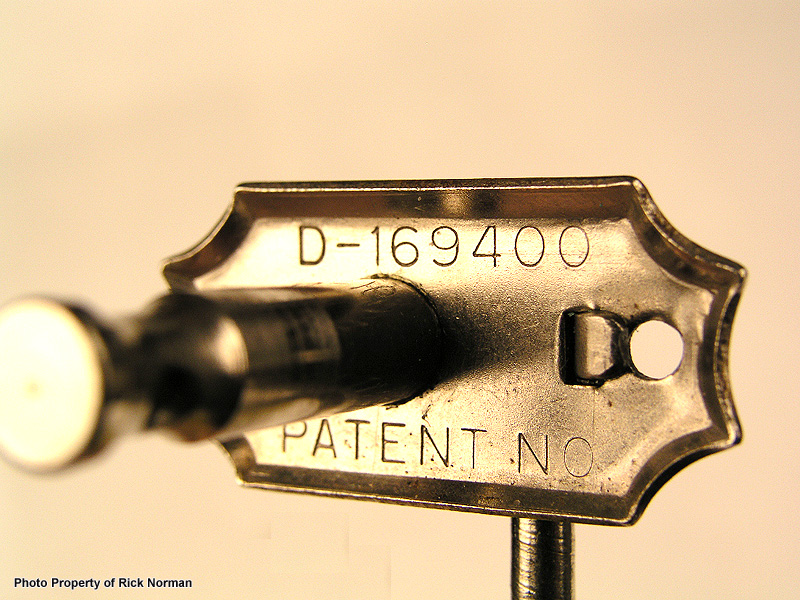

Version 6
Mid-1960 - 1964 Les Paul, ES and SG Tuners
This version is the beginning of the 'Double-ring' era. Mechanically, the metal portions of the tuners are the same as the first 'Patent No' tuners, but the plastic tuner buttons now have two rings at the base of the button. During this era, they were still 'Single-line' models. They seemed to consistently feature the small lubrication hole. They're now classified as:
Single-line, Double-ring Here's an example and please note that the back of these tuners look just like the example shown in Version 5, so please refer to that picture for the back view:
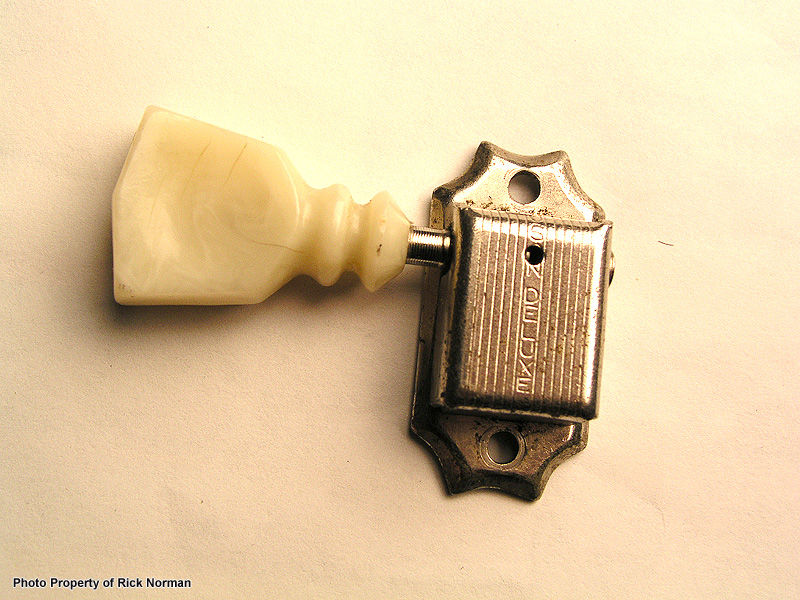

Version 7
1965 - 1969 SG, ES and Les Paul Tuners
This version marked the transition to the 'Double-line' era. There are now two lines of writing down the back of the gear cover. These tuners retained the double-ring buttons, although the color began its slide into 'green-ness'. Also, the lubrication hole seemed to settle in to being consistently the large version. They are now classified as:
Double-line, Double-ring
Here's a good example, unfortunately, with no button, but still a good example. As before, please note that the back of these tuners look just like the example shown in Version 5, so please refer to that picture for the back view:
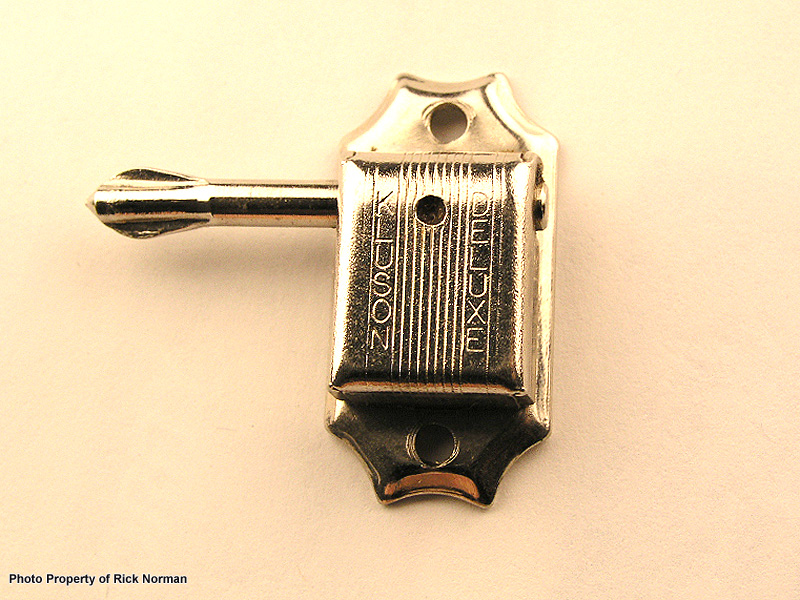

Version 8
1969 - 1974 SG, ES and Les Paul Tuners
This version represent the last of the Kluson® line used by Gibson. The original company continued to manufacture tuners and a huge assortment of other metal parts for all manner of stringed instruments into the 1980s. In what I believe was a move to consolidate their tuner supplier, in approximately 1974/1975, Gibson began using Schaller open-back and sealed tuners in place of Kluson® and Grover® tuners. There was certainly some overlap of left-over stock of Kluson® tuners and what came after, so like all things Gibson, the timing of the disappearance of Kluson® tuners is not absolute.
This last version is still of the double-line, double-ring classification. This version marks a change in the wording. Now the lettering says 'Gibson' and 'Deluxe'. This version is also classified as:
Double-line, Double-ring
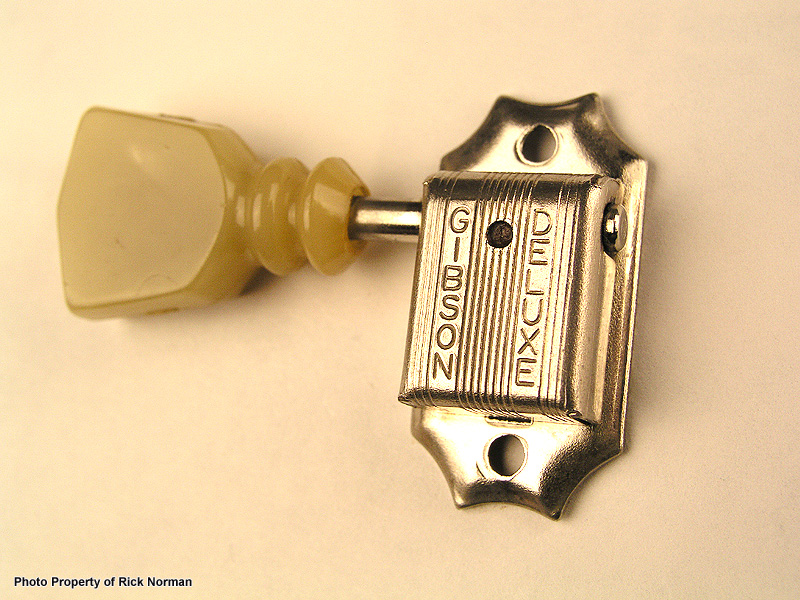
Another visual change is on the under-side of the base plate. The letters are the same, but now the lettering is imprinted deeper into the metal. I don't know if this was universal on this model, but all of the ones I've seen looked like this, for whatever that's worth.
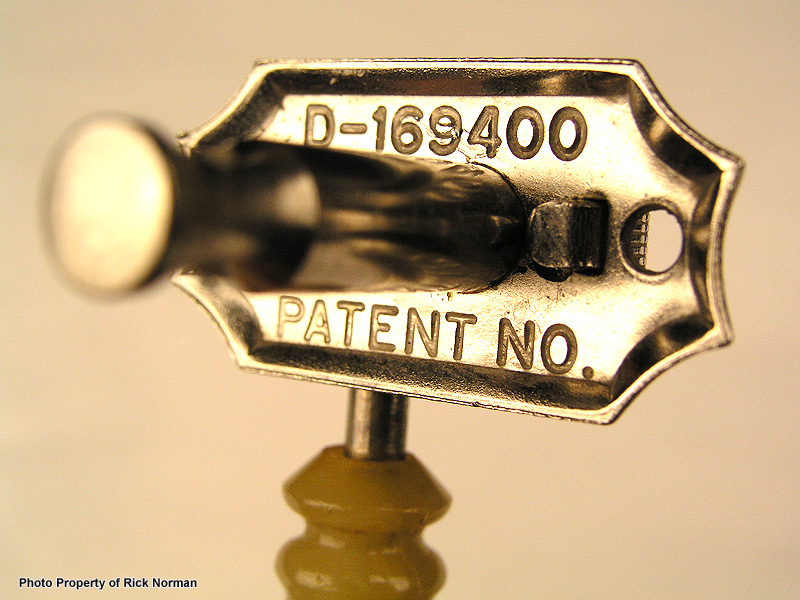

Earlier Variation
This is a tuner you'll likely never see on a Les Paul (perhaps on a jazz-box???), but since I had it to photograph, I thought I'd include it for the curious. This version is interesting in that the worm shaft doesn't protrude through the gear cover, which we've seen before, but there's also no lube hole in the top of the gear cover. It does have the early 'Pat. Appld.' letters stamped at the bottom of the cover, and the lettering down the center:
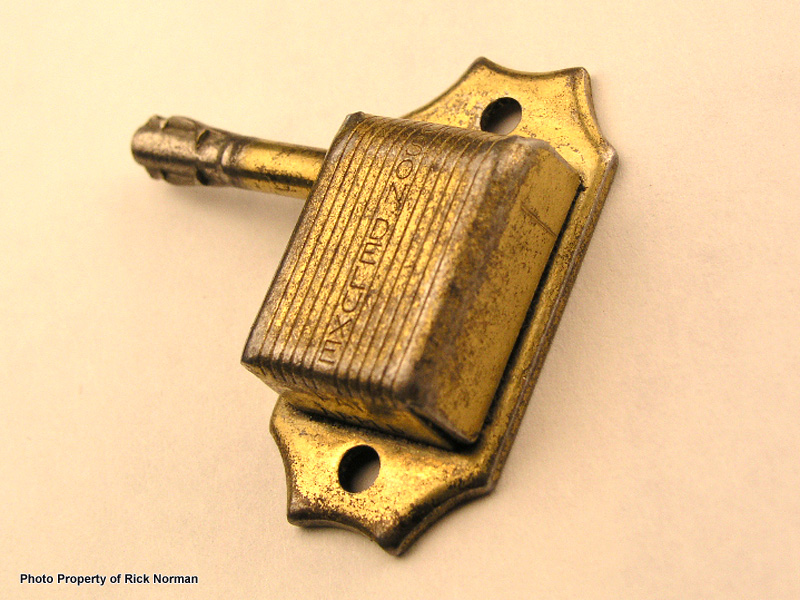
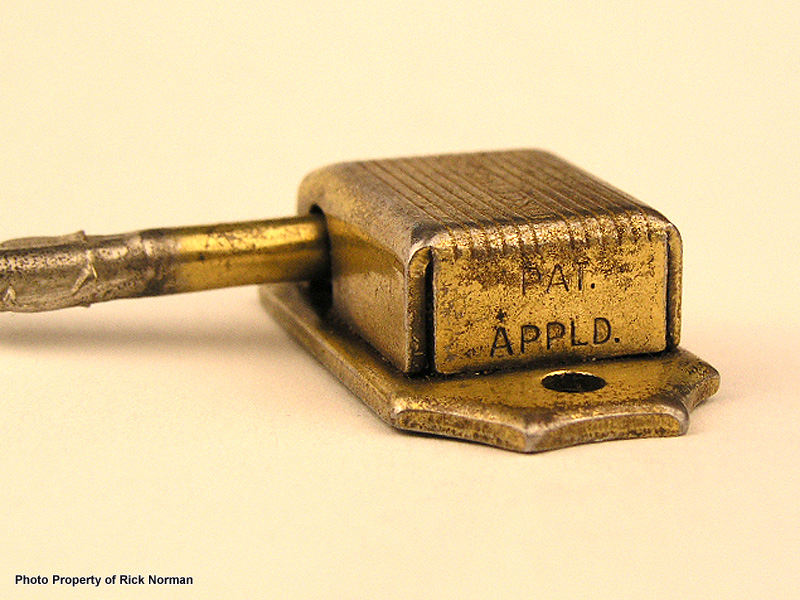
Note that the hole in the base plate that the shaft goes through is egg-shaped. This was to aid in assembly at the factory. On these models, the spur gear was attached to the tuner shaft by a rivet before assembling to the base plate (versus the staking for the later versions). The egg-shape allowed the assembled tuner shaft to be inserted through the base plate and moved into place, after which the gear cover was installed.
Also notice that the base plate 'looks' almost completely flat from the top... but it's not.
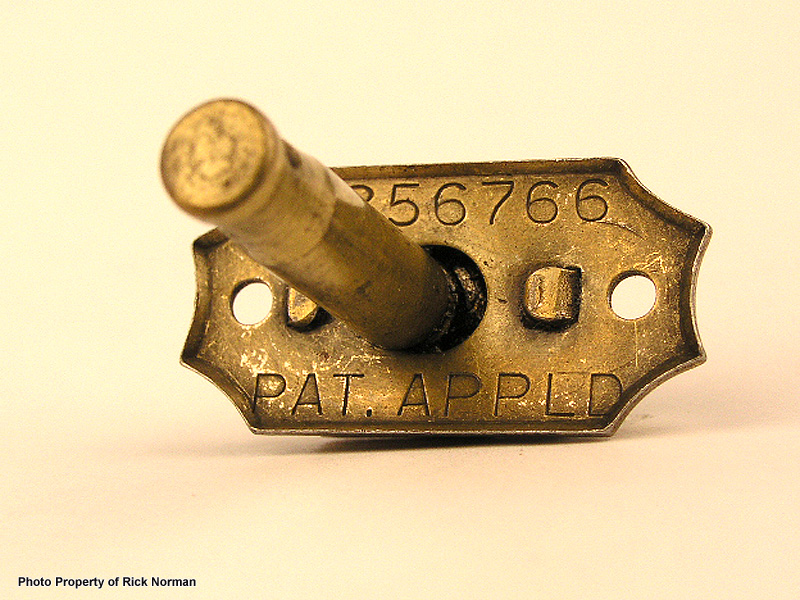

Other Visual Differences
Okay, there are other distinguishing things. The '50s versions of the tuners had the lines and patterns stamped into the gear cover, as did the '60s versions. There was a slight variation in the positioning of the pattern when the 'double-line'; variation arrived.
Here are views of the top and bottom of the gear cover for practically any 'single-line' tuner you may see. Notice that the lines stamped into the gear cover wrap all the way over the top of the cover, and that the bottom of the cover is basically plain. The exception, of course, were the early 'Pat. Appld' tuners with those letters stamped into the bottom of the cover:
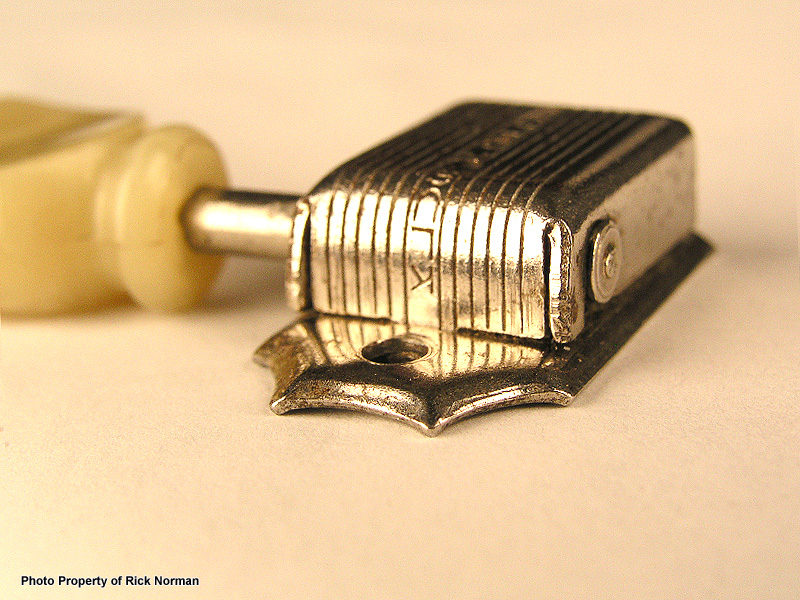

By contrast, here are views of the top and bottom of the gear cover for the 'double-line' tuners. Notice that the lines stamped into the gear cover have receded somewhat where they wrap over the top of the cover, and that they begin to wrap around the bottom of the cover:
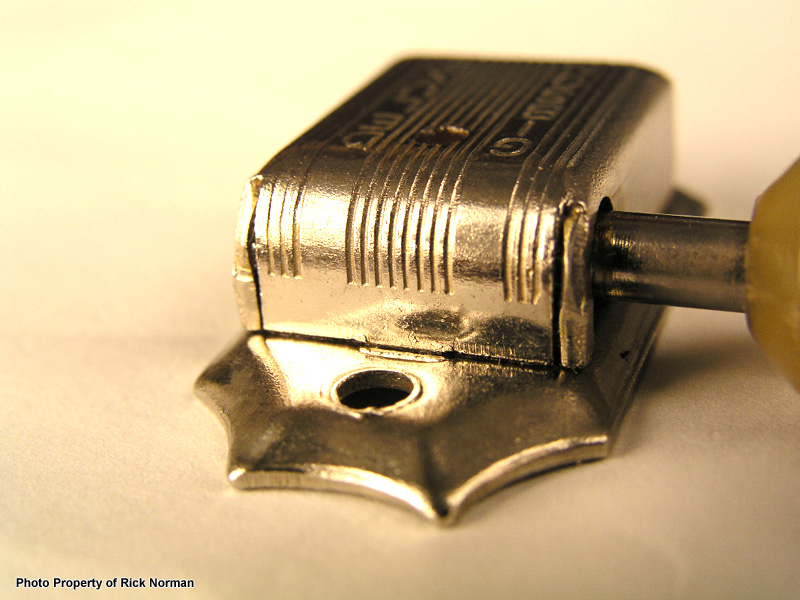
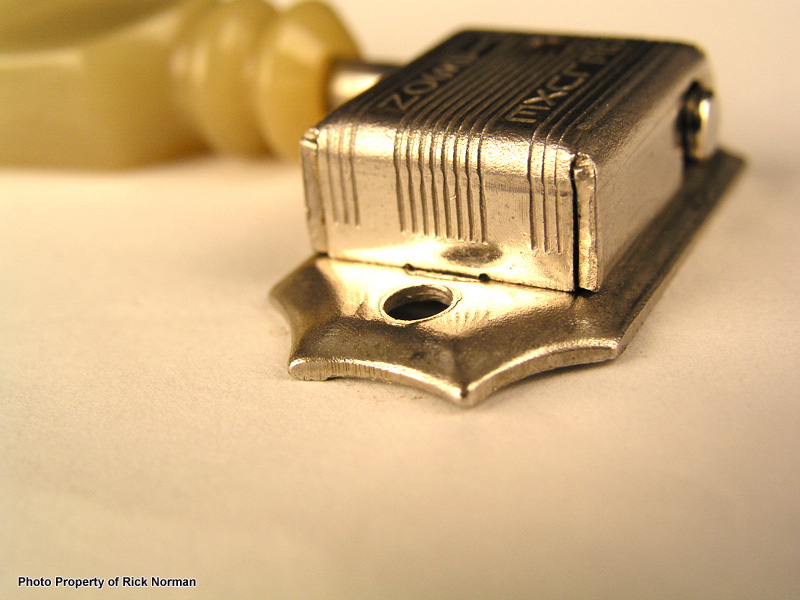

The Incredible Shrinking Buttons
One of the interesting things about the tuning buttons is that certain years appear to have had batches which had a slightly different chemical formula for the plastic the buttons were cast from. These are seen most-often on 1959 guitars but there are definitely cases of decaying buttons even earlier (thought not nearly as many). Something funny in the plastic has these buttons age less 'gracefully' than the buttons before or after. As the chemical mixture deteriorated, the buttons became a dark, reddish-brown, shrank, and got very crystalline and flaky. The deterioration can get so bad that the button reaches a point where it will literally crumble in your fingers as you attempt to tune the guitar.
There are a number of different methods that various technicians use to attempt to preserve the crumbling buttons. Some are more successful than others. This page won't go into any of them. I personally advocate removing the crumbling tuners, carefully storing them, and buying a replacement set from a vintage parts dealer, or using modern reproductions. This way the guitar is playable, and the original parts can be saved without risking further damage. I do this myself on my old Gibsons - meaning installing modern repros for every-day playing and store the originals - crusty buttons or not - and there are many other vintage guitar owners who do exactly the same thing.
This section will show some pictures of a few particularly crusty buttons - it's almost artistic to look at... All of the individual tuners in these photos come from the same set of tuners from a 1959 gold-hardware guitar. A couple of the tuners had buttons that are in great shape, and the rest are auditioning for a part in the next 'Return Of The Mummy' movie. This demonstrates again that there was overlap in batches of parts.
This shot shows a beautiful, intact original tuner button:
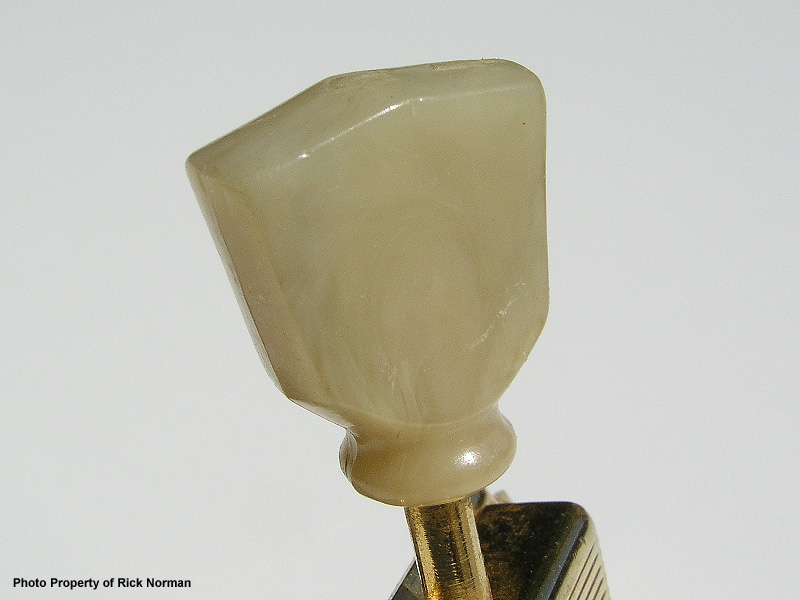
The following three pictures are of other tuners in the same 1959 set - these are classic shrunken, flaky tuner buttons:
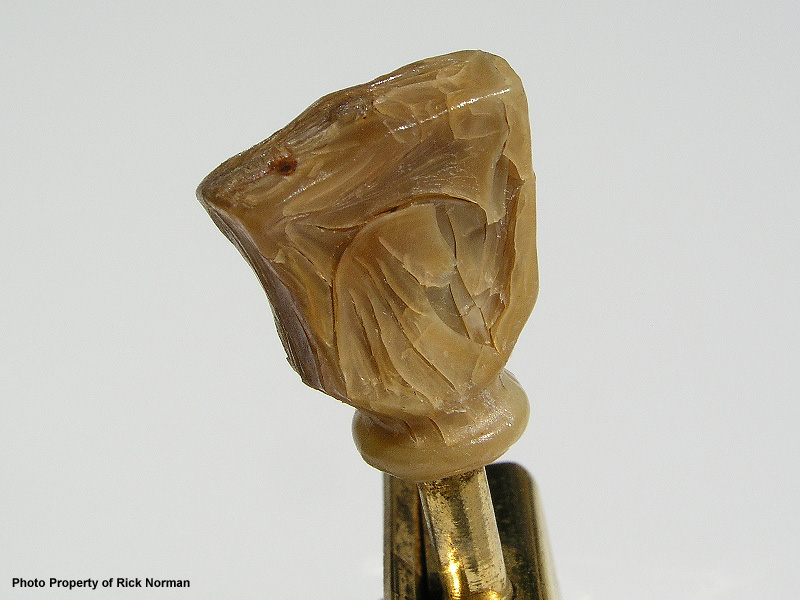
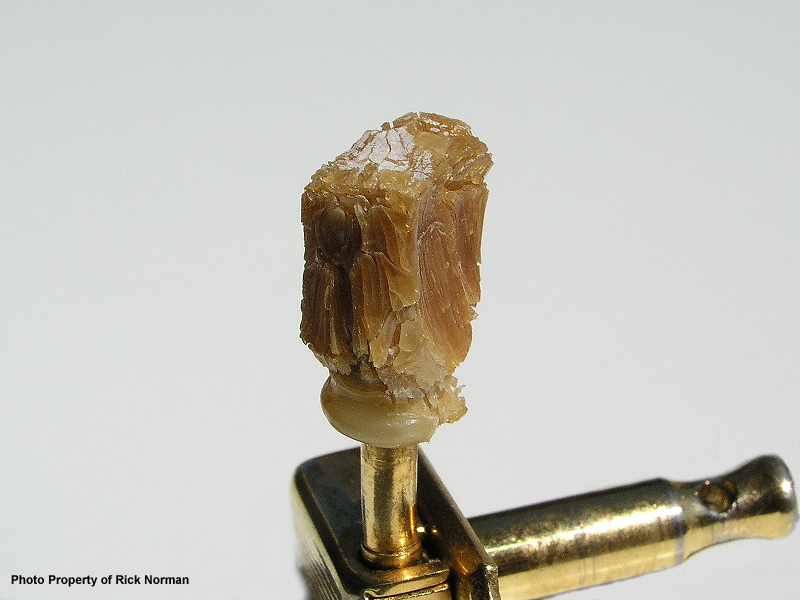
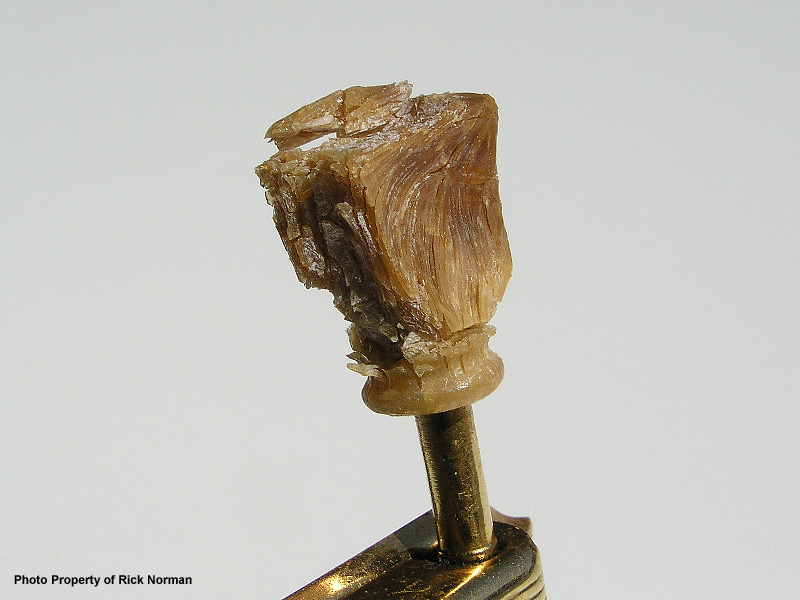
I'll make a brief exception to my statement about not addressing strip tuners. This is to show that the oval buttons on the strip tuners aren't exempt from the shrinkage problem. The plastic formula for the oval buttons was obviously different than that which was used for the tulip buttons. Hence the mechanics of the shrinkage is different. But shrink and crumble they do! These buttons are on a set of strip tuners from an early-1957 Les Paul Junior:
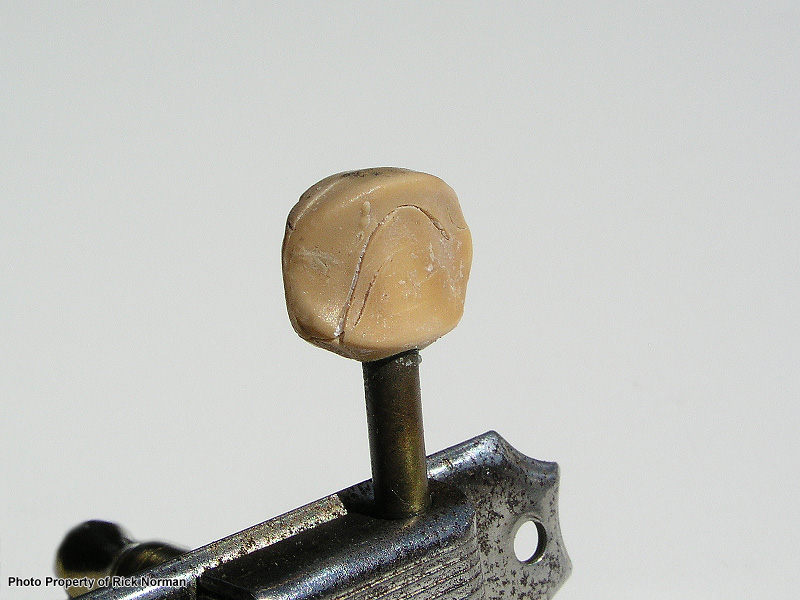
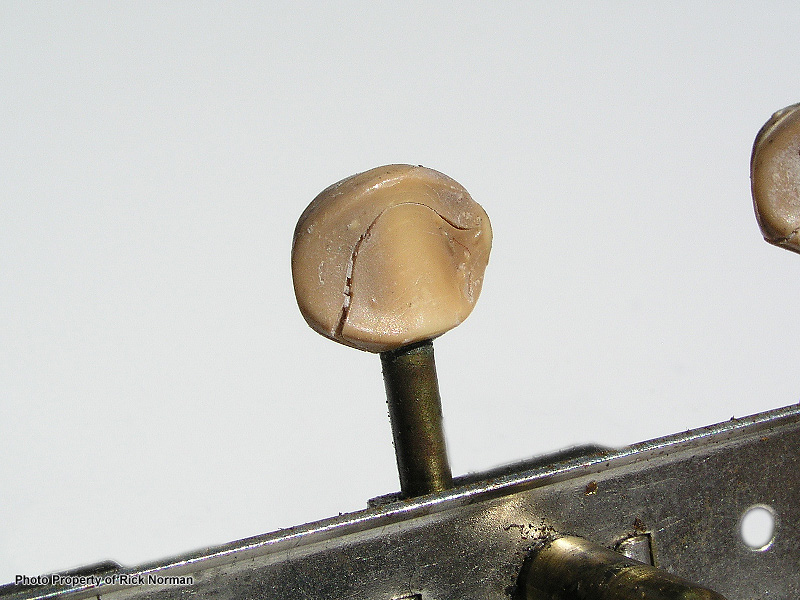

Kluson® Inner Workings Revealed
This section is for the 'gear-heads' only. (Sorry, bad joke... I never claimed to have a sense of humor...) What follows is an exploded view showing the parts of these tuners and how they fit together.
This shot shows all of the working parts of the tuner. No button is shown, since that changed over the years. At the back is the gear cover. Below the gear cover, from left-to-right: The worm-shaft; the spur gear; the base plate; and the tuner shaft.
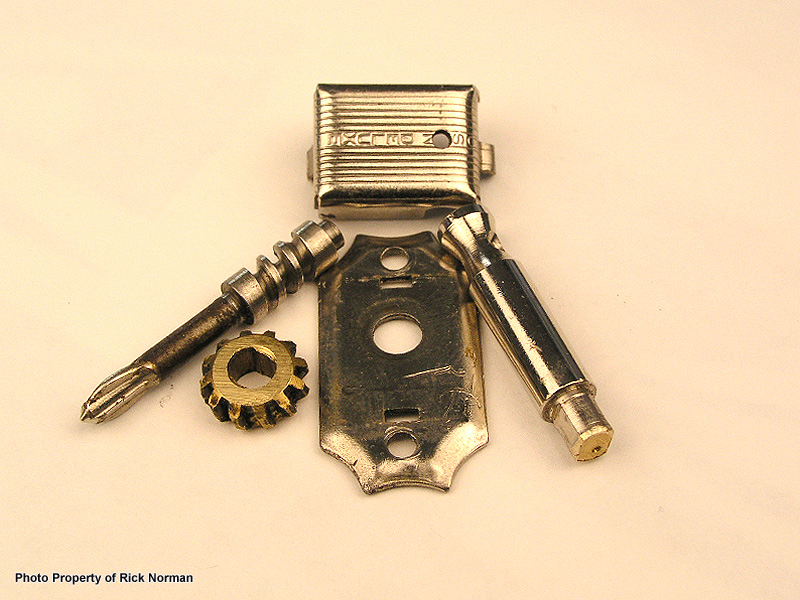
This picture shows the brass spur gear. Notice the flatted sides of the hole in the center:
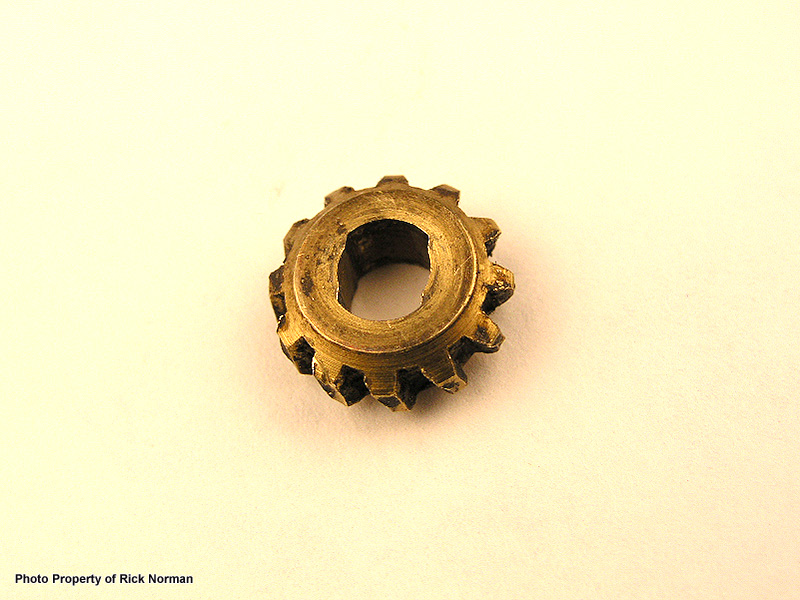
This is the end of the tuner shaft that fits into the spur gear. It also has flatted sides to mate up with the spur gear:
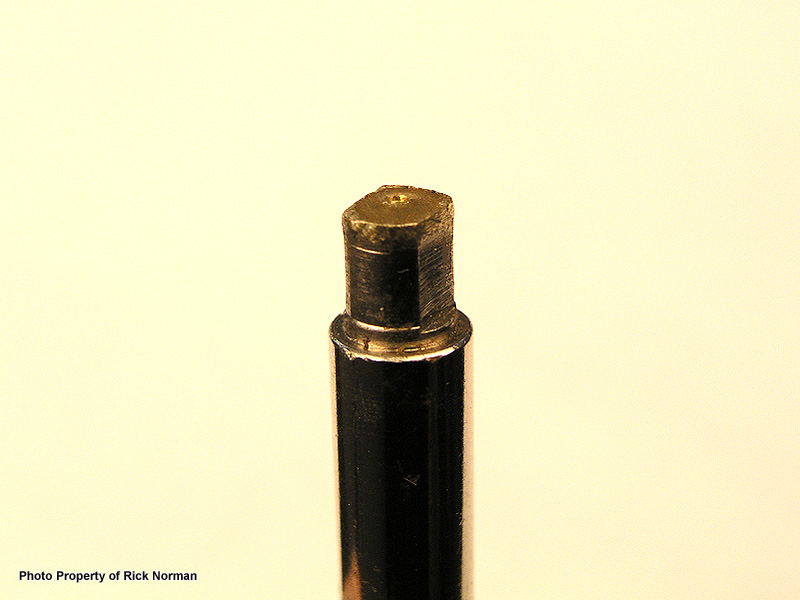
Here's how the two pieces fit together:
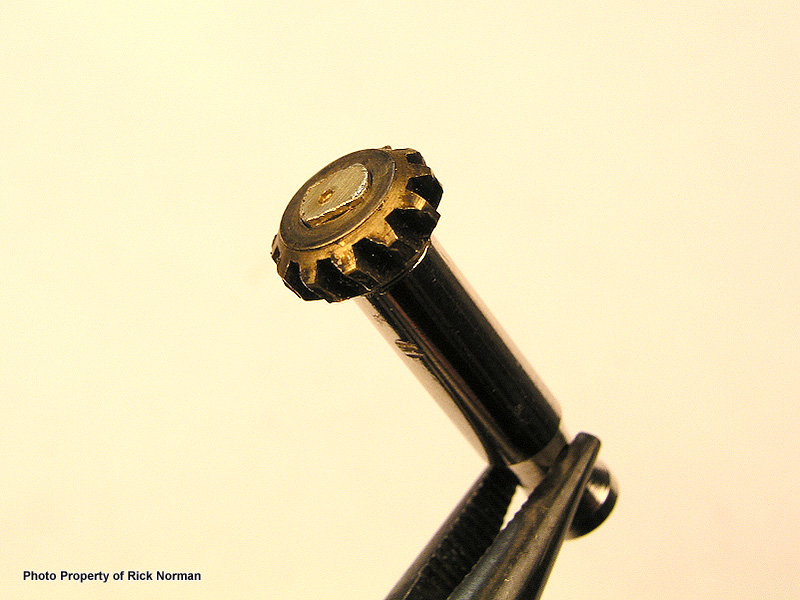
In practice, the shaft was first placed through the hole in the base plate, then the spur gear installed, and then the end of the tuner shaft was staked, which expands the metal in the area, and pressures the parts in place (the indentation in the end of the shaft is evidence of the staking):
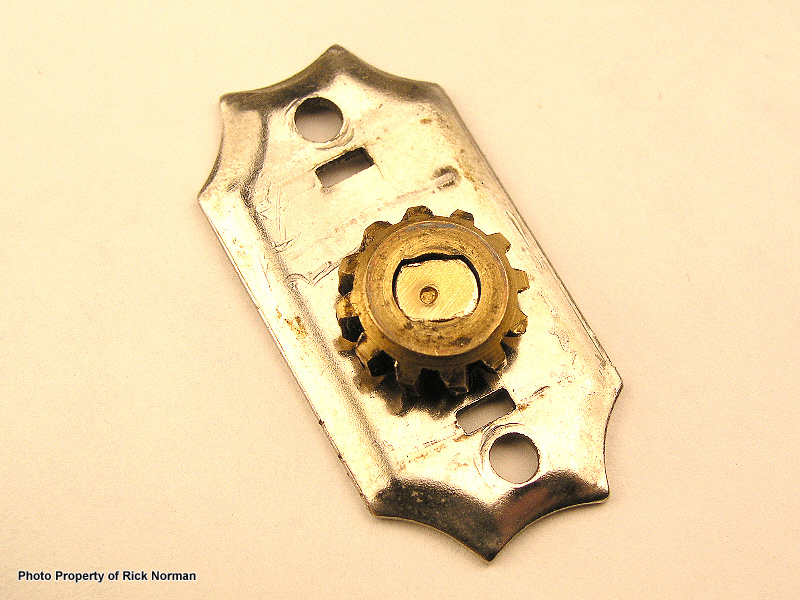
This picture below shows how the worm shaft mates up with the spur gear. As the worm shaft rotates by turning the button, the worm 'moves', and drives the teeth of the spur gear in either direction. The gear ratio of the tuner is determined by the pitch of the worm and the number of teeth on the spur gear. The early tuners were 12:1 ratio. As the ratio advanced to 14:1 in later years, and to the higher ratios of the currently-available tuners, that's achieved by decreasing the pitch of the worm and increasing the number of teeth on the spur gear.
The reason for using a worm/spur arrangement is that the worm shaft can turn the spur gear, but as string tension tries to rotate the tuner shaft, it actually locks the spur gear against the worm. The spur gear cannot cause the worm shaft to rotate, as long as the tolerances are good. As the tuners age and wear, the increased tolerances can (not necessarily will) allow some slippage. Another source of slippage comes from the fact that the gear cover sometimes loosens, allowing misalignment and slippage. And further, I've had a few cases of the gear cover having been stamped wrong so it sat on the base plate crooked from the factory, and the worm and spur gear alignment sucked.
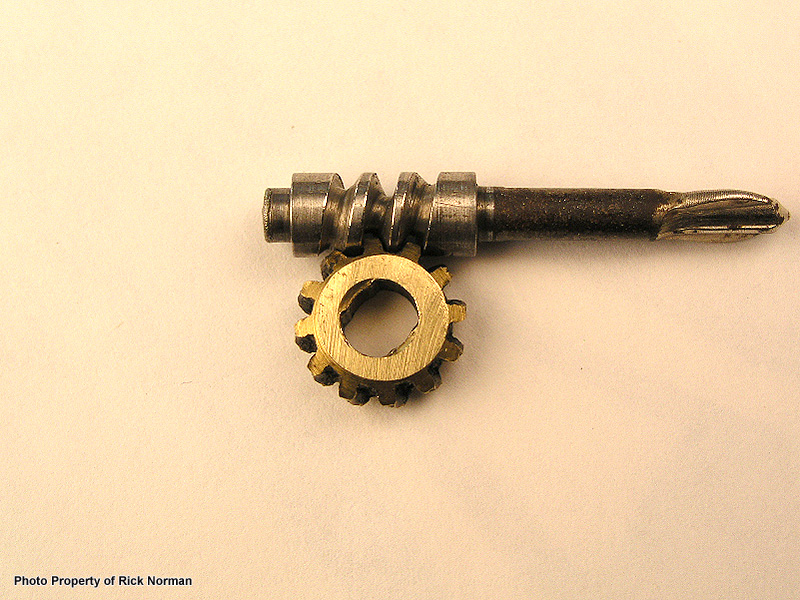
This is how things look when things are in place on the base plate:
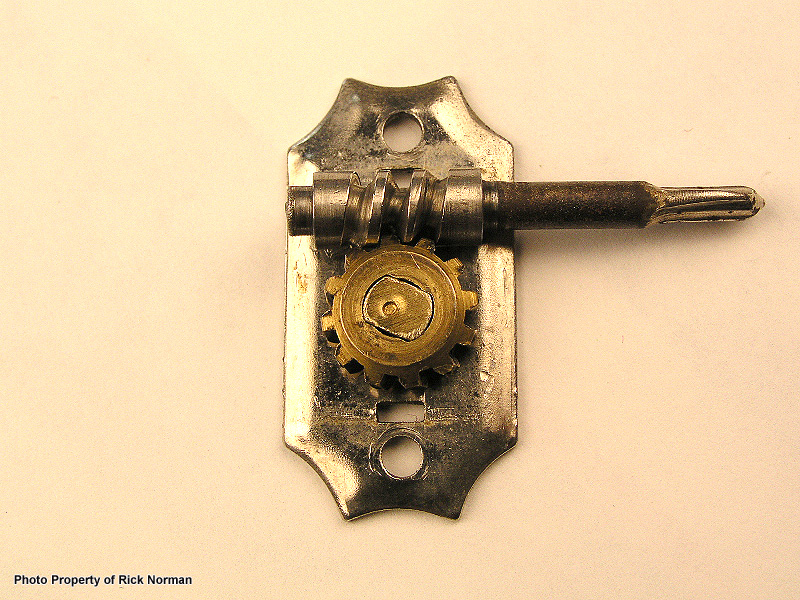
This picture shows how tightly things fit inside the gear cover. The gear cover is the key to keeping everything in their proper orientation.
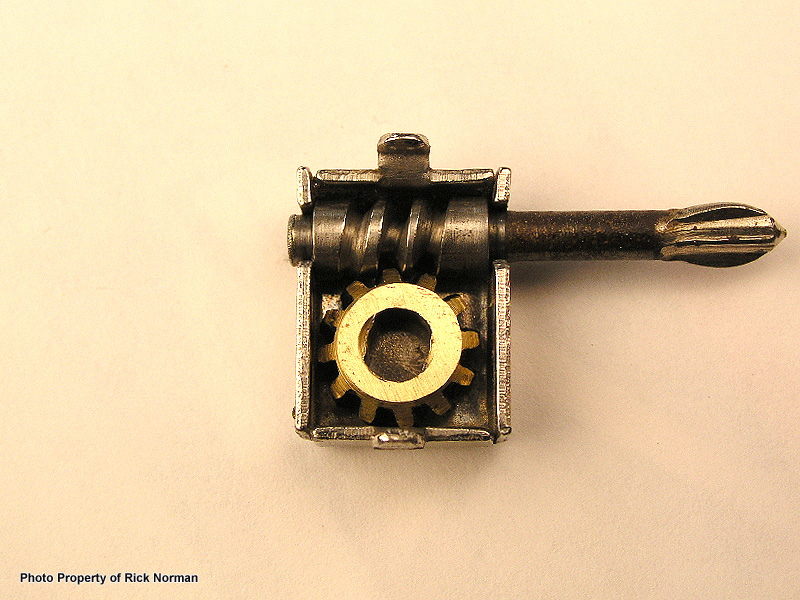

Acknowledgements
I'd like to acknowledge and thank the following people for their generosity in loaning these valuable items for my inspection and camera lens:
- Kim LaFleur
- Terry Mueller
- "Uncle Lou" Gatanas
- Bill Fajen
I'd like to acknowledge and thank the following people for their generosity and massive tolerance with my endless questions in getting this as accurate as I can make it:
- Terry Mueller, for his wide knowledge and all the endless emails.
- Lou Gatanas
- Tom Wittrock
- Bill Fajen
KlusonŽ is a registered trademark of W.D. Music Products, Inc.
|




















































